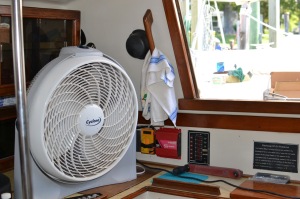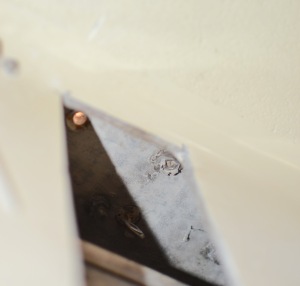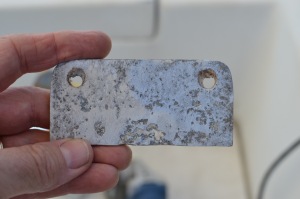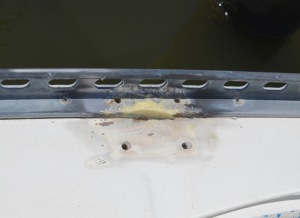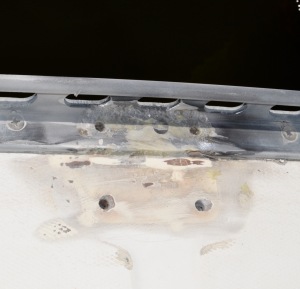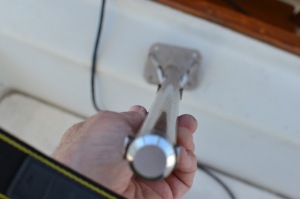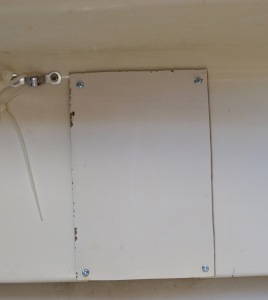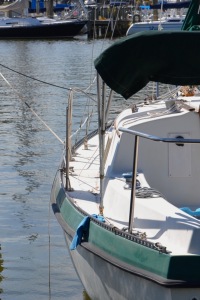This post originally appeared on Windborne in Puget Sound
Finally, I have completed the last of the three cockpit bimini canvas pieces: the center section. This panel is zipped to both the forward and aft roof panels, meaning that its size is completely dependent on the placement of those two panels; they had to be completed first.
But because the old center panel had to continue in service until the new one was fabricated, the forward and aft panels had to be properly located. In other words, because I did this work in sections instead of all at once, the new roof duplicated the old completely...
Because the old center panel fit perfectly, rather than pattern the center panel with DuraSkrim I chose to simply roll out some Sunbrella and trace the outline of the old center onto it. The size is not terribly critical; instead it is the zipper placement that is crucial. That being the case, I did a lot of measuring and annotating on the old center panel:
Again, placement of the zippers is what controls the fit here. So I measured outside-tooth to outside-tooth at perhaps a dozen stations along the old panel. Then, when applying the zippers to the new panel, I duplicated the station locations and ensured that the zippers conformed to the measurements.
I have learned thru this project that zipper position in a lengthwise direction is also critical, especially when there are pairs spanning the length. To make this work out properly, I followed these steps:
- Locate the centers of both the old and new panels by folding in half, and mark them.
- Install the old center panel, and transfer the center markings to the forward and aft panels.
- Work on one edge at a time, I started with the aft edge. Install one of the new zipper halves to the aft panel zipper.
- Hold up the new panel, matching the center marks.
- While continuing to hold the panel in place (you may need help here), make match marks on the new zipper half and the center panel an inch or three away from the center.
- Remove the new zipper half from the aft panel.
- Position the new zipper half on the new panel using SeamStick basting tape, matching up the match marks. Note: at this point, with no other reference it is not possible to exactly locate the zipper width-wise. Instead, using another new zipper half on the opposite edge, simply ensure that zipper placement will allow both zippers to fall approximately equally on the fabric. Exact spacing at the measurement stations will be established when the opposite zipper half is installed.
- After sewing the first zipper half, take the panel out to the cockpit again and zip it up. Install another new zipper half on the other aft panel zipper.
- Pull the panel firm athwartship, and make match marks on the new zipper half.
- Following the steps above, install the second zipper half.
At this point, zipper installation is half done, with the attachment to the aft panel complete. Complete the forward zippers in a similar fashion, with these two modifications:
- When establishing the position of the first zipper half, match up the centerline marks as before. But this time, slide the panel a little port and starboard, watching for wrinkles to form and dissipate. You are looking for that placement where there are no wrinkles - it may fall when the centerlines are not quite matched up. Match mark the zipper half and the new panel.
- When sticking the zippers in place with SeamStick, be very, very careful to get the outside-tooth to outside-tooth spacing at the measurement stations the same as on the old panel.
 |
| Ta DAAA! |
So, what did it all cost? I'm afraid I can't be entirely accurate because I used some supplies from earlier projects. But what I
can do is to make an estimate on materials costs, based on the Sailrite catalog I have here on board (check the
Sailrite website for current prices):
| Item | Quantity | Unit Cost | Extended Cost |
| Sunbrella, Erin Green, 46" wide | 10 yd | 16.95 | 169.50 |
| DuraSkrim | 10 yd | 2.95 | 29.50 |
| Binding tape, 3/4", Erin Green | 80 ft | 0.50 | 40.00 |
| Zipper, #10, 48" | 6 | 7.50 | 45.00 |
| Zipper, #10, 60" | 4 | 8.70 | 34.80 |
| Zipper Pull, #10 | 10 | 1.70 | 17.00 |
| Zipper Stop, Stainless | 2 packs of 10 | 2.50 | 5.00 |
| Common Sense fastener, male | 50 | 0.60 | 30.00 |
| Common Sense fastener, eyelet | 17 | 0.195 | 3.32 |
| Rivet | 100 | 0.15 | 15.00 |
| Seam Stick, 3/8" | 1 | 8.95 | 8.95 |
| Seam Stick, 1/4" | 1 | 6.95 | 6.95 |
| TOTAL |
|
| $405.02 |
|
I also bought some tools that, tho they were used in this project, will be used again in future projects. I don't know if these should be charged against this project or not (you decide), but you should definitely have these tools to do the work:
| Item | Cost |
| Rivet Setting Tool Kit | 89.00 |
| Common Sense Eyelet Hole Punch | 69.50 |
I did not include the cost of the thread because I bought a large spool years ago and have been using it since. You definitely want the Teflon Tenara thread or equivalent - it will outlast your boat. Don't settle for polyester thread.
And finally, you need a heavy-duty sewing machine to handle this. I heartily recommend the Sailrite LS-1 or LSZ-1 (zig zag - if you intend to sew sails). They are expensive and worth it. We got ours used for less than half the new cost.
































